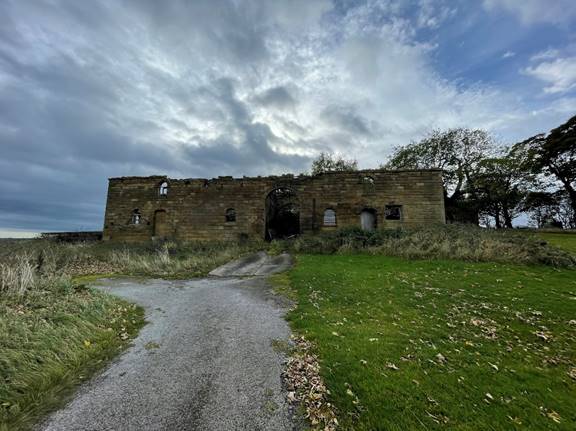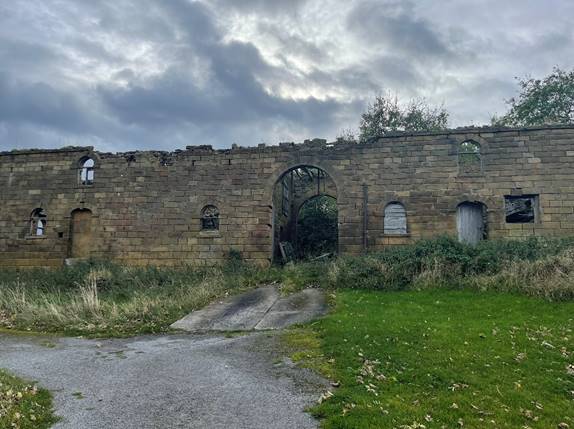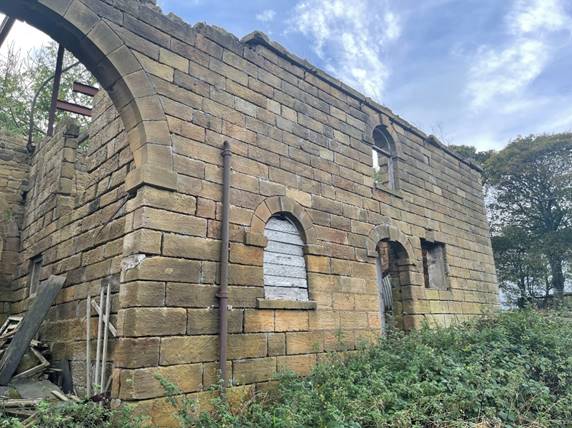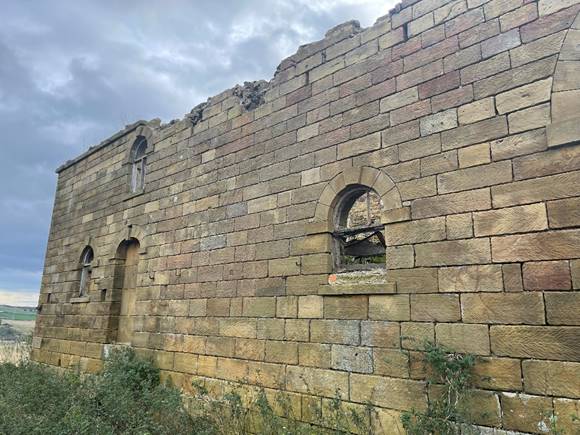|
|
Matthew Farndale
FAR00383
|
|
Dates are in red.
Hyperlinks to other pages are in dark blue.
Headlines are in brown.
References and citations are in turquoise.
Context and local history are in purple.
1850
Matthew Farndale, the son of
Martin and Elizabeth Farndale, nee Taylor (FAR00264) of Fogga was born at Skelton on 25 June 1850 and baptised at Skelton on 24 July 1850 (Skelton PR & IGI). Martin was a labourer.
Matthew Farndale’s birth was registered at Guisborough in the third quarter of
1850 (GRO Vol 24 page 455).
1851
Census - 1851 - Skelton- Fogga Farm:
James Taylor, head, age 74, widower, born Barnby, farmer 70 acres.
Elizabeth Farndale, 40, marr, daughter and wife of Martin Farndale, born
Fylingdales (ie 1811).
Martin Farndale, 33, marr, born Easby, Son-in-law (ie born 1818).
William Farndale, son of Martin, age 8, born Skelton, grandson (FAR00356).
Martin Farndale, son of Martin, age 5, born Skelton, grandson (FAR00364).
John Farndale, son of Martin, age 2, born Skelton, grandson (FAR00376).
Matthew Farndale, son of Martin, age 9, born Skelton, grandson (FAR00383).
1861
Census 1861 – 61 Galey Hill, Hutton Lowcross:
Martin Farndale, head; marr; age 42; agricultural
labourer; born Easby (1819).
Elizabeth Farndale, wife; age 44; born Skelton (1817).
John Farndale, son; age 12; scholar; born Skelton (1849) (FAR00376).
Matthew Farndale, son; age 10; scholar; born Skelton (1851) (FAR00383).
1871
Census 1871 – Hall Farm, Kilton
Martin Farndale, aged 71 (this was
FAR00236, not his father Martin)
Elizabeth Farndale (not his mother but
his great uncle’s wife), 66
Matthew Farndale, 22, born 1849, a servant
Several other servants working on the farm
1879
Martin Farndale's (FAR00364) two brothers lived
nearby; John the next lived at Loftus and worked on the LNER and Matthew farmed
at Craggs Hall near Brotton. There is a story that, while living at Tranmire
(or possibly before, in August 1879, according to one record), Martin asked Matthew
to go and take Craggs Hall for him. On his return Matthew said that he had
taken it, but for himself! It was said that when Matthew came back and told
Martin what he had done, they both walked back to Kilton
Thorpe without saying a word. Martin however always spoke highly of his brother
who helped him to get to Tidkinhow, a
farm on Wharton estate. It is said that Matthew later lent Martin some money to
acquire Tidkinhow Farm and that Martin
took this in part as repayment of his previous 'loan' and for the rest, Matthew
used to come to Tidkinhow each year for
many years to claim the three best lambs as part repayment.

Cragg Hall Farm is a Farmhouse, probably late seventeenth with adaptations and
alterations through the eighteenth and nineteenth centuries. Sandstone, mainly
laid to courses, with pan tile roof and brick stacks. Plan: derived from
longhouse tradition, now referred to as 'false longhouse'. One and a half
storey to the west forming the house with washhouse at the western end, single
storey to the east containing the cross passage and gable entry byre. The house
part of the range has two cells, each with its own stairs to rooms above.
Blocked doorways show that the upper rooms of the house, washhouse and cross
passage attic were formally interconnected. Exterior, North façade: Two bay
house with horizontal sliding sashes at first floor. Ground floor has
horizontal sliding sash to right and a three over three vertical sliding sash to left with small fixed light fire window to far left.
Left gable wall with stone flagged coping and main stack. Second stack to
centre, for inner room. Horizontal building break at ground floor lintel height
with slightly better quality masonry above. Single bay
outbuilding to right of a building break with single, reduced, ground floor
window. Stone flagged coping to left gable wall with low brick stack. Cross
passage to left of house covered by single storey outshut with a single window.
Byre to left with stone buttress and stone flagged coping to gable. Exterior,South façade: House part of the range has only one
opening on the south side: a single small fixed light for the inner room. To
the left, at the foot of the inner room stairs, there is a low blocked doorway.
To the left of this is the doorway to the washhouse with a small outshut to its
left. Entry to the house is via the cross passage to the right of the house.
The external door to the cross passage is C20. To the right there is a small
four light window. Vertical building breaks between the cross passage and both
the byre and house. Building break between the house and washhouse less clear.
No apparent horizontal building break to the house to correspond to that on the
north façade. Exterior, east gable end (byre): Stable door to left of
centreline, unglazed attic window to centre. Exterior, west gable end
(washhouse): Small blocked window at attic level to left of central stack.
Small C20 fixed light set in blocked doorway to outshut on the right. Building
break between outshut and washhouse. Interior, cross passage: Concrete floor.
Exposed ceiling joists, of which at least one appears riven, supporting broad
planks with rolled edge moulding. Planked doors to both outshut and house, that
to the house using narrow planks with bevelled edges. Interior, fore room: Stone
flagged floor, exposed ceiling joists with alternate joists riven and sawn, the
sawn joists being chamfered. Broad floor boards above
with rolled edge detail. Similar broad planks with rolled edge detail used for
the screen between the hearth and the door to the cross passage, and for the
timber partition with doors for the staircase. Hearth with small cast iron
range. Salt box to left. Interior, Inner parlour: Raised timber floor. Exposed
ceiling joists, some roughly chamfered supporting narrow floor
boards with rolled edge mouldings. Timber partition for staircase with
narrow planks with bevelled edge, (similar to those
used for the door between the cross passage and fore room). Door between inner
parlour and foot of fore room stairs is also planked but uses narrow planks
with rolled edge moulding. Interior, washhouse: Brick and concrete surround for
a solid fuelled copper built in front of earlier hearth. Interior, byre: Cobble
floor. Remains of timber stalls.
SOURCE: Royal Commission on the
Historical Monuments of England, 1987 "Houses of the North York
Moors".
HISTORY: Construction of yeomen farmsteads following and
developing the medieval longhouse tradition (where animals and people shared
the roof of a linear building range) continued on the
North York Moors up until about the mid 18th century. From the late 17th
century, existing and new longhouses developed piecemeal, improving the
standard of accommodation for the farmer and
increasing the degree of separation from the animals. False longhouses were
those examples which were built with separate entrances for people and animals,
rather than being adapted from those where the entrance to the byre was
originally from the cross passage. Longhouse farmsteads were frequently adapted
as the needs and the wealth of the farmers changed over time. House parts were
often raised and extended. Outbuildings could come into domestic occupation or
be returned to auxiliary use. Accommodation was frequently subdivided to
provide for widows or joint heirs (as North York Moors yeomen frequently did
not employ primogeniture inheritance), and then recombined at
a later date.
SUMMARY OF IMPORTANCE: Cragg Hall Farm is an example of the
continuation of the North York Moors vernacular tradition of longhouse
construction. The series of modifications that are still identifiable by the
various building breaks in the masonry, blocked openings
and styles of internal timberwork, all eloquently demonstrate the evolutionary
nature of longhouses through the 17th to 19th centuries. It is this succession
of alterations which make Cragg Hall Farm of particular
special architectural and historical interest, showing how adaptable the
longhouse tradition was to changing tastes and circumstances.
1880

Matthew Farndale of Craggs
Hall aged about 30, 1880
1881
Census 1881 - 1, Kilton
Village:
‘Bessie’ (Elizabeth?) Farndale, head; widow; age
70; born Whitby? (1811).
John Farndale, son; u/m; age 32; railway porter;
born Skelton (1849) (FAR00376).
Matthew Farndale, son u/m; age 30; ag lab; born
Skelton (1851) (FAR00383).
1884
Matthew Farndale, married Mary Ann Liverseed in
1884 at Stockton District (MR).

Matthew Farndale at about
the time of his marriage.
1885
Robert Farndale (FAR00606) was born at Craggs
Hall Farm on 20 August 1885 (Brotton
PR).
1886
Ruth Farndale (FAR00619) was born at Craggs Hall
Farm on 14 December 1886 (Brotton
PR).
1889
Earnest Farndale (FAR00633) was born at Craggs
Hall Farm in 1889 (Brotton
PR).
1891
Census 1891 - Craggs Hall Farm, Brotton:
Matthew Farndale, head, 40
Mary A Farndale, 34
Robert Farndale, 5
Ruth Farndale, 4
Ernest Farndale 2
Elizabeth Farndale, widow; aged 80; born
Whitby; (1811).[Shown
as mother to Matthew Farndale of Craggs Hall].
Annie Mitchel, a domestic servant
Whitby Gazette, 31 July
1891: CARLING HOW.
PICNIC. The Wesleyan picnic, which had been postponed from Wednesday, was held
on Saturday last in a field near Craggs Hall, kindly leant by Mr M Farndale.
The children were regaled with milk and the provisions that remained from the
tea held on the Wednesday. A number of games were
indulged in until dusk.
1892
Herbert Farndale (FAR00652) was born at Craggs
Hall Farm on 30 Mar 1892 (Brotton
PR).
1894
William Farndale (FAR00665) was born at Craggs
Hall Farm on14 July 1894 (Brotton PR).
1898
Edwin Farndale (FAR00691) was born on 23 July
1898 at Brotton (Brotton PR).
1900

Matthew Farndale and his wife Mary Ann (nee Liverseed) at
Craggs Hall in about 1900

Matthew
and Ann Farndale and their family at Craggs Hall in about 1900
William
Robert
Ruth
Matthew Herbert Ann Ernest
Edwin
1901
Census 1901, Craggs Hall Farm
Matthew Farndale, head, 50, a farmer
Mary A Farndale, 44
Robert Farndale, 15, an assistant on the
farm
Ruth Farndale, 14
Ernest Farndale, 12
Herbert Farndale, 9
William Farndale, 6
Edwin Farndale, 2
1911
Census 1911, Craggs Hall Farm
Matthew Farndale, head, 60, a farmer
Mary A Farndale, 54
Ruth Farndale, 24, at home
Ernest Farndale, 22, at home
Herbert Farndale, 19, at home
William Farndale, 16, at home
Edwin Farndale, 12, school
The Whitby Gazette, on 8
December 1911 reported: FOUNDATION STONE LAYING AT CARLIN HOW. The Carlin How and
Skinningrove District has grown very rapidly during the last few years, and, in
order to cope with the increasing demand for accommodation, the friends of the
Wesleyan body have decided to build a new Wesleyan Church at Carlin How. The
cost of the church will be £850, £500 of which has already been raised or
promised. Mr T C Hutchinson, managing director of the Skinningrove iron works,
has generously given the site. The buildings will be of brick, and will
accommodate about 250 people. Mr. A Farndale is the architect, and Mr J K
Wilson is superintending the work of erection. The foundation stone laying
ceremony took place on Wednesday, in the presence of a good company. The Rev W
Powell, Loftus conducted the ceremony, and stones were placed by Mrs M Moore,
Westfield, Loftus,… C Farndale …. M Farndale, Craggs Hall... Mr E Lofthouse
laid a stone in memory of the late Mr. A Murray weather, a prominent Brotton
Wesleyan. The Rev J C Adelard (Saltburn) gave an address and a public tea took
place in the preaching room, which has, for many years, done duty as a place of
worship, but is now totally inadequate to meet the demands made-up on it.
1915
Whitby Gazette, 25 June
1915: BROTTON.
A successful picnic for the Brotton Wesleyan Sunday School was held at Craggs Hall
on Wednesday, by permission of Mr and Mrs M Farmdale.
The event was attended by a number of parents,
scholars and others. Tea was provided and games were indulged in by young and
old.
1916
Whitby
Gazette, 22 September 1916. CARLING HOW. During the weekend, the Wesleyans at Carlin
Howl held their harvest festival services. On Sunday, the Rev H Mortimer, Staithes,
preached twice, and on Monday evening a public meeting was held. The Rev H
Mortimer addressed the meeting, and gave a helpful and inspiring address. Mr
Arthur Garnett presided. The sale of fruit and vegetables took place at the
close of the meetings. Collections were taken at all the services, which were
well attended, and the total proceeds, which amounted to £7, will be devoted to
the Trust Funds. The vote of thanks to all helpers and those who had given
fruit etc, was proposed by Mr Hutchinson, and seconded by Mr M Farndale. Miss Pearson,
“Mount Pleasant,” presided at the organ, and the chapel was tastefully
decorated for the occasion.
1917
Whitby Gazette, 7 December
1917: A
lecture entitled “Life amongst tramps and social outcasts,” was given in the
Carlin How Wesleyan Church, last week, by the Rev Harry Mortimer, Staithes. The
lecture, which was very interesting, was a descriptive account of work in
Manchester Wesleyan Mission, with which Mr Mortimer was for some time
identified. Mr M Farndale, Craggs Hall, presided.
1920

Mary Ann Farndale in front of Craggs
Hall in about 1920

Mary
Ann Farndale (FAR00397) had vivid
memories of holidays at Cragg Hall Farm. (Mother is adamant that
she knew it is Cragg & not Craggs as on your site?) Matthew (FAR00383), affectionately called
Mattha by Mary Ann was an elderly widower by then and he appeared to enjoy her
fussing over him. My mother remembers a
beautiful rose garden hidden at the back of the farm seen only by those at the
farm, fruit bushes dripping with
berries, taking the farmworkers lunches out to the fields at midday, being
allowed to go shopping on her own to Carlin How or Brotton (an example of the
changes in society as she was only 5 or 6 at the time) and reading Pilgrims
Progress in the rarely used ‘front room’
A special treat was to be taken for rides in the side car of Herbert’s (FAR00652) motor bike. Herbert, Matthews’ son was presumably running
the farm by this stage. (Record from Judith Bremner)
1923
Cleveland Standard, 23
June 1923: PROPERTY
MARKET. At Loftus on Wednesday, Mr T S Patch, auctioneer, offered for sale the Craggs
Hall Farm, situated between Brotton and Carlin How. The purchase would only buy
one half the revenue derived from the estate. Mr H Farndale, son of Mr M
Farndale, tenant of the farm, became the purchaser for £1,500. The solicitor
for the vendor was Mr Julius Bertram, of London.
1927
Matthew Farndale, age 76 died at Guisborough
District in the first quarter 1927 (Brotton
PR)(DR).
THE FUNERAL AT
BROTTON OF MR MATTHEW FARNDALE. The funeral of Mr Matthew Farndale, of Craggs Hall,
Carlin How, took place at Brotton, yesterday afternoon, in the presence of a
considerable number of mourners. The chief mourners were Miss farndale,
daughter, Eastbourne; Mr Robert Farndale, Leeds, Mr William Farndale,
Northallerton, Mr E Farndale, Walbottle, sons; Mr M Farndale,
Tidkinhow, Boosbeck, brother; Mr R Liverseed, Loftus, Mr A Liverseed,
Stockton, brothers in law. There were in the cortege farmers and
representatives of the agricultural interests from all parts of Cleveland. The Rev
John Hunt, Wesleyan Minister, Loftus conducted the burial service in Brotton Wesleyan
church.
Cleveland Standard, 5
March 1927: The
death has taken place at Craggs Halll, Carling How, of Mr Matthew Farndale, a well known Cleveland farmer, who
was 76 years of age, and had lived at Craggs Hall 44 years. Mr Farndale, who
had been in failing health for some time, had the reputation of being one of
the best cultivators of land and hedges in the district.
He was buried on 2 March
1927 at Brotton.
Gravestone Brotton Old Churchyard;
‘In loving memory of Ernest, beloved son of
Matthew and Mary A Farndale of Craggs Hall who died 30 November 1913 aged 24
years. Also the above named Matthew who died 27th
February 1927 aged 76 years. Also the above named Mary
Ann who died 4th November 1933 aged 77 years. (Mon R)

1933
Mary Farndale, Matthew’s
widow, died on 4 November 1933.
Cleveland Standard, 11
November 1933: Funeral
of Mrs M A Farndale. The funeral took place this week of Mrs Mary Ann farndale,
of Craggs Hall, Brotton, widow of the late Mr Matthew Farndale, who was well
known in Cleveland farming circles. A large company was present at the Wesleyan
Church, where the service was held. It was conducted by the Rev F A Wenyon, of Loftus, and the Carlin How Methodist Church
choir was also present. Mr William Hedley, of Kilton Thorpe, was at the organ.
Internment took place that brought on churchyard.
Craggs Hall Farm in 2021:










